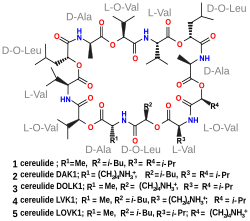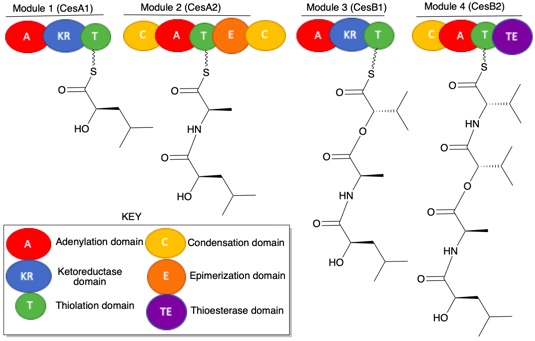 | |
| Names | |
|---|---|
| IUPAC name cyclo[D-alanyl-N-oxa-L-valyl-L-valyl-N-oxa-D-leucyl-D-alanyl-N-oxa-L-valyl-L-valyl-N-oxa-D-leucyl-D-alanyl-N-oxa-L-valyl-L-valyl-N-oxa-D-leucyl] | |
| Other names 1,7,13,19,25,31-Hexaoxa-4,10,16,22,28,34-hexaazacyclohexatriacontane, cyclic peptide derivate; Cyclo(D-alanyl-3-methyl-L-2-hydroxybutanoyl-L-valyl-4-methyl-D-2-hydroxypentanoyl-D-alanyl-3-methyl-L-2-hydroxybutanoyl-L-valyl-4-methyl-D-2-hydroxypentanoyl-D-alanyl-3-methyl-L-2-hydroxybutanoyl-L-valyl-4-methyl-D-2-hydroxypentanoyl) | |
| Identifiers | |
3D model (JSmol) | |
| ChemSpider | |
PubChem CID | |
CompTox Dashboard (EPA) | |
| |
| |
| Properties | |
| C57 H96 N6 O18 (D-Ala-D-O-Leu-L-Val)3 | |
| Molar mass | 1152 |
| extremely low | |
| Hazards | |
| Occupational safety and health (OHS/OSH): | |
Main hazards | Neurotoxicant |
Except where otherwise noted, data are given for materials in their standard state (at 25 °C [77 °F], 100 kPa). | |
Cereulide is a toxin produced by some strains of Bacillus cereus , Bacillus megaterium and related species. It is a potent cytotoxin that destroys mitochondria. It causes nausea and vomiting.
Contents
Cereulide acts as ionophore with a high affinity to potassium cations. Exposure to cereulide causes loss of the membrane potential and uncoupling of oxidative phosphorylation in the mitochondria. [1] [2] The nausea and vomiting is believed to be caused by cereulide's binding and activation of 5-HT3 receptors, leading to increased afferent vagus nerve stimulation. [3]
Cereulide is a cyclic dodecadepsipeptide resembling valinomycin; it contains three repeats of four amino acids: D-Oxy-Leu—D-Ala—L-Oxy-Val—L-Val. It is produced by a dedicated non-ribosomal peptide synthesis (NRPS) system in B. cereus. [4]
The spores of cereulide-producing strains of B. cereus and related species are manyfold more heat resistant than spores of cereulide non-producers. The toxin has no loss of activity upon autoclaving, cooking, or baking. [1]
